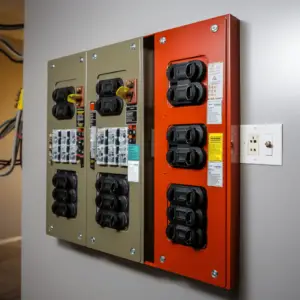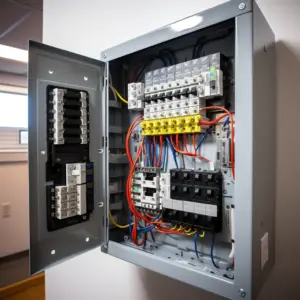Electrical panel installation, If you’re planning to install a new electrical panel, the first thing you need to ask yourself is – flush mount or surface mount? This is the question that plagues many homeowners and even more contractors.
Table of Contents
Flush Mount vs Surface Mount Electrical Panel

While on the surface, they may appear similar, some subtle and not-so-subtle differences between the two should be addressed before you decide where to put your electrical panel.
Surface Mounted Electrical Panel
The surface-mounted electrical panel is the most popular type of panel. The main reason for this is that it is cost-effective, easy to install, and requires less space.
These panels are usually found in residential homes and small businesses. They are also used in industrial buildings that do not require a lot of power.
Surface-mounted panels have two parts: the cover plate and the box frame. The cover plate is what you see on the wall, while the box frame is what holds the circuit breakers inside.
Surface-mounted panels come in different sizes and shapes, depending on what they’re being used for. For example, a surface-mounted panel can only hold 30 amps worth of breakers, while another can hold up to 100 amps worth.
The size and shape of your surface-mounted panel will also determine how many circuits you can run through at one time and how many outlets you can have wired into Electrical panel installation.
What are the Advantages of a Surface Mount Electrical Panel?
Surface mount electrical panels are popular in new construction because they’re easy to install but can also be used in remodeling projects. They tend to be cheaper than other types of panels and can be more efficient.
Ease of Installation
One of the biggest advantages of a surface-mounted electrical panel is that it’s easy to install. The panel doesn’t require the same level of access as other types of panels, so you don’t have to worry about cutting through walls or ceilings to get it installed. In addition, there’s no need for a lot of wiring or conduit because everything is contained within the panel.
Space Saver
Surface-mounted electrical panels are much smaller than other types of panels, so they take up less space in your home. This means you’ll have more room for storage or even extra furniture if you want it. You might even be able to use some of your old furniture pieces again without having to buy new ones!
Cost Savings
Surface-mounted electrical panels are cheaper than other types because they’re easier and quicker to install. However, this doesn’t mean they’re cheap quality .
Flush Mounted Electrical Panel
A flush-mounted electrical panel is a very efficient and reliable way to install your electrical system. When you have a flush-mounted electrical panel, you can easily access the controls without having to remove any panels. It also allows for easy cleaning of your home’s interior.
A flush-mounted electrical panel is a very efficient and reliable way to install your electrical system. When you have a flush-mounted electrical panel, you can easily access the controls without having to remove any panels. It also allows for easy cleaning of your home’s interior.
This type of panel is usually installed in basements, but it can be installed in any room in the house. It is commonly used in homes built during the 1970s and 1980s, but some people still prefer this type of panel over newer models because they feel more durable and safer than other types of panels available today.
What are the Advantages of a Flush Mount Electrical Panel?
The advantages of using a flush mount electrical panel in your home include:
- Flat design – The lack of a mountain flat against the wall, mainly against the wall, makes it more aesthetically pleasing. This also allows you to access any wires that are installed inside the panel without having to remove the entire unit from its location.
- Increased safety – Since there are no mounting brackets to catch fire, there can be no sparks between them and your home’s structure, potentially leading to a fire hazard.
- Low profile – Because the unit does not have any mounting brackets attached, it will be less visible when installed on your home’s walls or ceilings so that it does not interfere with your decorating style or become an eyesore for visitors who may spend time in your home.
Which Panel should you Choose for your Application?
Flush mount panels offer several advantages over their surface-mounted counterparts:
- They’re easier to install because they don’t require holes drilled through walls or ceilings for wires to run through them.
- They provide more room for wiring because there’s no need for extra space around them once installed.
- They’re usually less expensive than surface panels because they require fewer parts and fewer labor hours.
What is the Difference Between a Flush Mount and an Electrical Panel

Surface mount and flush mount electrical panels are affixed to the wall, respectively. Surface mount panels are on top, while flush mount panels are in the wall.
Flush mount panels can be used in any room and take up less space than surface mount panels. This makes them perfect for smaller spaces or rooms with built-in cabinets.
Due to their no-drill installation, surface mount panels are suitable for larger rooms or open floor plans.
Summary
While both flush and surface mount panels offer similar levels of protection against the elements and have the same general function, each has its own benefits. Ultimately you will want to choose the type of electrical panel that meets the needs of your home.
Electrical panel installation, are using a mechanical room for your panel, you need to make sure that if a flush mount is what you want, you plan for the extra space to accommodate the depth of the panel.
